JEEP CHEROKEE 2021 Owner handbook (in English)
Manufacturer: JEEP, Model Year: 2021, Model line: CHEROKEE, Model: JEEP CHEROKEE 2021Pages: 332, PDF Size: 8.87 MB
Page 71 of 332
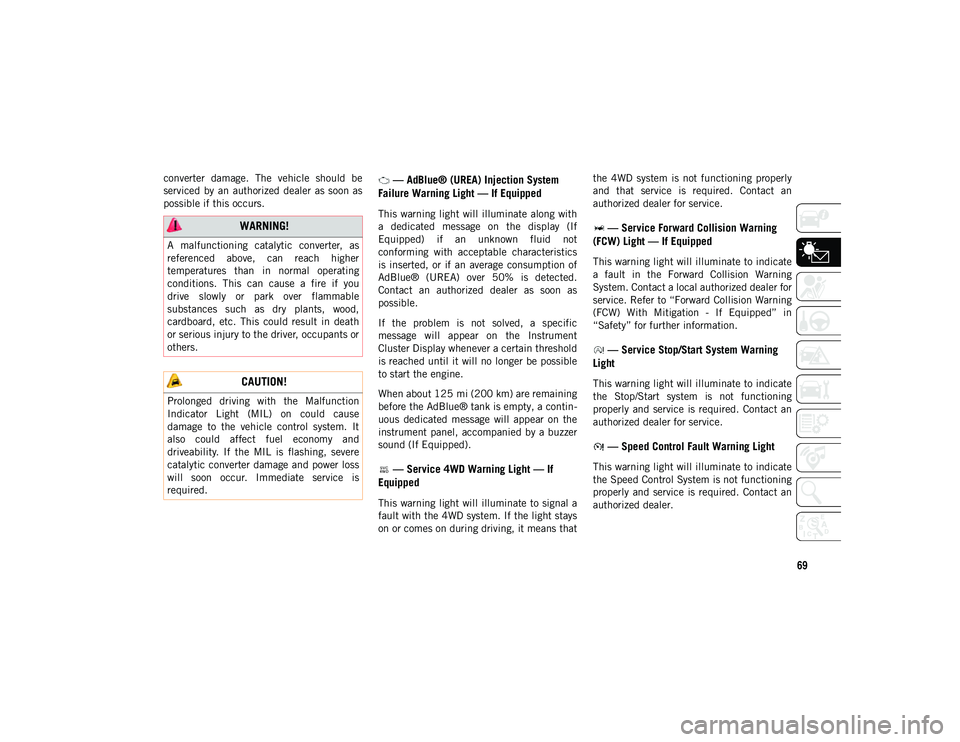
69
converter damage. The vehicle should be
serviced by an authorized dealer as soon as
possible if this occurs. — AdBlue® (UREA) Injection System
Failure Warning Light — If Equipped
This warning light will illuminate along with
a dedicated message on the display (If
Equipped) if an unknown fluid not
conforming with acceptable characteristics
is inserted, or if an average consumption of
AdBlue® (UREA) over 50% is detected.
Contact an authorized dealer as soon as
possible.
If the problem is not solved, a specific
message will appear on the Instrument
Cluster Display whenever a certain threshold
is reached until it will no longer be possible
to start the engine.
When about 125 mi (200 km) are remaining
before the AdBlue® tank is empty, a contin -
uous dedicated message will appear on the
instrument panel, accompanied by a buzzer
sound (If Equipped).
— Service 4WD Warning Light — If
Equipped
This warning light will illuminate to signal a
fault with the 4WD system. If the light stays
on or comes on during driving, it means that the 4WD system is not functioning properly
and that service is required. Contact an
authorized dealer for service.
— Service Forward Collision Warning
(FCW) Light — If Equipped
This warning light will illuminate to indicate
a fault in the Forward Collision Warning
System. Contact a local authorized dealer for
service. Refer to “Forward Collision Warning
(FCW) With Mitigation - If Equipped” in
“Safety” for further information.
— Service Stop/Start System Warning
Light
This warning light will illuminate to indicate
the Stop/Start system is not functioning
properly and service is required. Contact an
authorized dealer for service.
— Speed Control Fault Warning Light
This warning light will illuminate to indicate
the Speed Control System is not functioning
properly and service is required. Contact an
authorized dealer.
WARNING!
A malfunctioning catalytic converter, as
referenced above, can reach higher
temperatures than in normal operating
conditions. This can cause a fire if you
drive slowly or park over flammable
substances such as dry plants, wood,
cardboard, etc. This could result in death
or serious injury to the driver, occupants or
others.
CAUTION!
Prolonged driving with the Malfunction
Indicator Light (MIL) on could cause
damage to the vehicle control system. It
also could affect fuel economy and
driveability. If the MIL is flashing, severe
catalytic converter damage and power loss
will soon occur. Immediate service is
required.
2020_JEEP_CHEROKEE_UG_RHD_UK.book Page 69
Page 72 of 332
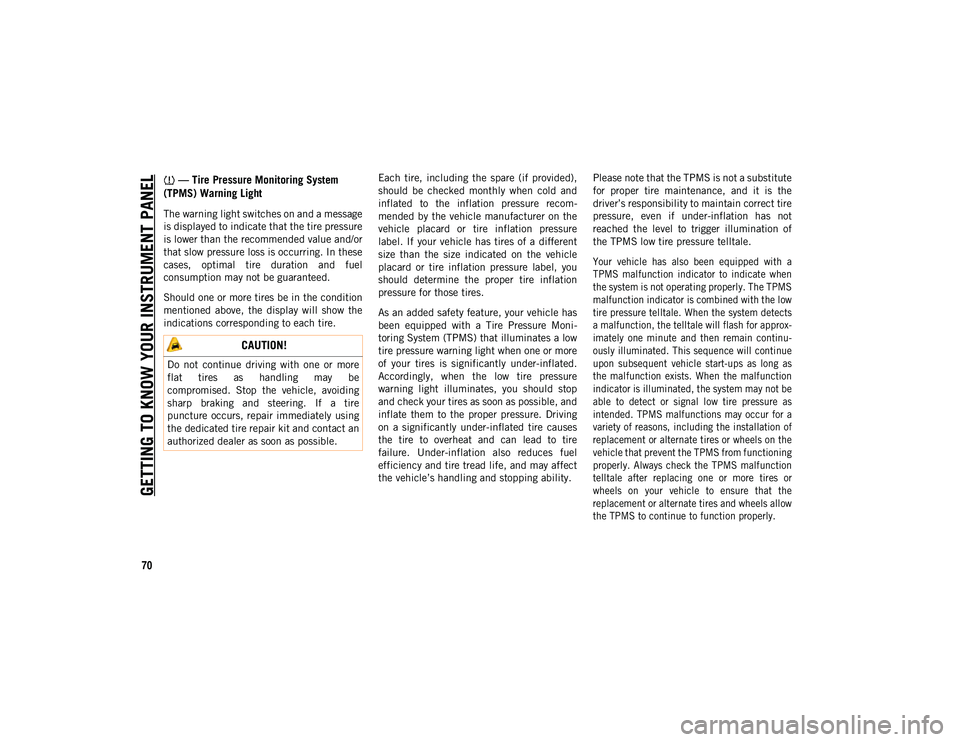
GETTING TO KNOW YOUR INSTRUMENT PANEL
70
— Tire Pressure Monitoring System
(TPMS) Warning Light
The warning light switches on and a message
is displayed to indicate that the tire pressure
is lower than the recommended value and/or
that slow pressure loss is occurring. In these
cases, optimal tire duration and fuel
consumption may not be guaranteed.
Should one or more tires be in the condition
mentioned above, the display will show the
indications corresponding to each tire. Each tire, including the spare (if provided),
should be checked monthly when cold and
inflated to the inflation pressure recom
-
mended by the vehicle manufacturer on the
vehicle placard or tire inflation pressure
label. If your vehicle has tires of a different
size than the size indicated on the vehicle
placard or tire inflation pressure label, you
should determine the proper tire inflation
pressure for those tires.
As an added safety feature, your vehicle has
been equipped with a Tire Pressure Moni -
toring System (TPMS) that illuminates a low
tire pressure warning light when one or more
of your tires is significantly under-inflated.
Accordingly, when the low tire pressure
warning light illuminates, you should stop
and check your tires as soon as possible, and
inflate them to the proper pressure. Driving
on a significantly under-inflated tire causes
the tire to overheat and can lead to tire
failure. Under-inflation also reduces fuel
efficiency and tire tread life, and may affect
the vehicle’s handling and stopping ability. Please note that the TPMS is not a substitute
for proper tire maintenance, and it is the
driver’s responsibility to maintain correct tire
pressure, even if under-inflation has not
reached the level to trigger illumination of
the TPMS low tire pressure telltale.
Your vehicle has also been equipped with a
TPMS malfunction indicator to indicate when
the system is not operating properly. The TPMS
malfunction indicator is combined with the low
tire pressure telltale. When the system detects
a malfunction, the telltale will flash for approx
-
imately one minute and then remain continu -
ously illuminated. This sequence will continue
upon subsequent vehicle start-ups as long as
the malfunction exists. When the malfunction
indicator is illuminated, the system may not be
able to detect or signal low tire pressure as
intended. TPMS malfunctions may occur for a
variety of reasons, including the installation of
replacement or alternate tires or wheels on the
vehicle that prevent the TPMS from functioning
properly. Always check the TPMS malfunction
telltale after replacing one or more tires or
wheels on your vehicle to ensure that the
replacement or alternate tires and wheels allow
the TPMS to continue to function properly.
CAUTION!
Do not continue driving with one or more
flat tires as handling may be
compromised. Stop the vehicle, avoiding
sharp braking and steering. If a tire
puncture occurs, repair immediately using
the dedicated tire repair kit and contact an
authorized dealer as soon as possible.
2020_JEEP_CHEROKEE_UG_RHD_UK.book Page 70
Page 73 of 332
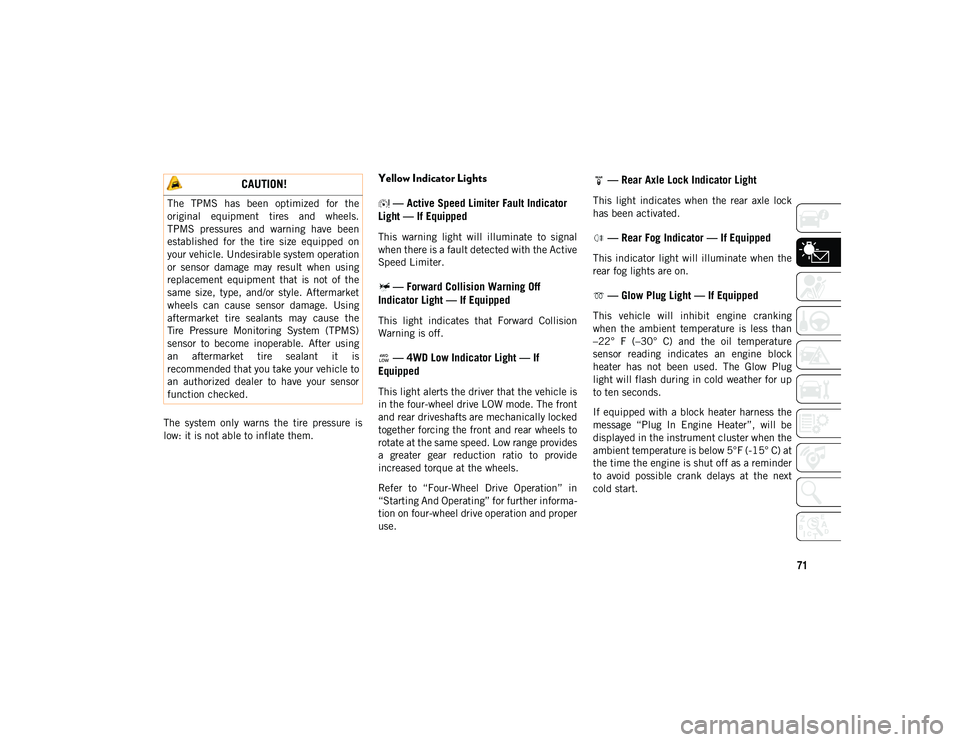
71
The system only warns the tire pressure is
low: it is not able to inflate them.
Yellow Indicator Lights — Active Speed Limiter Fault Indicator
Light — If Equipped
This warning light will illuminate to signal
when there is a fault detected with the Active
Speed Limiter.
— Forward Collision Warning Off
Indicator Light — If Equipped
This light indicates that Forward Collision
Warning is off.
— 4WD Low Indicator Light — If
Equipped
This light alerts the driver that the vehicle is
in the four-wheel drive LOW mode. The front
and rear driveshafts are mechanically locked
together forcing the front and rear wheels to
rotate at the same speed. Low range provides
a greater gear reduction ratio to provide
increased torque at the wheels.
Refer to “Four-Wheel Drive Operation” in
“Starting And Operating” for further informa -
tion on four-wheel drive operation and proper
use.
— Rear Axle Lock Indicator Light
This light indicates when the rear axle lock
has been activated.
— Rear Fog Indicator — If Equipped
This indicator light will illuminate when the
rear fog lights are on.
— Glow Plug Light — If Equipped
This vehicle will inhibit engine cranking
when the ambient temperature is less than
–22° F (–30° C) and the oil temperature
sensor reading indicates an engine block
heater has not been used. The Glow Plug
light will flash during in cold weather for up
to ten seconds.
If equipped with a block heater harness the
message “Plug In Engine Heater”, will be
displayed in the instrument cluster when the
ambient temperature is below 5°F (-15° C) at
the time the engine is shut off as a reminder
to avoid possible crank delays at the next
cold start.
CAUTION!
The TPMS has been optimized for the
original equipment tires and wheels.
TPMS pressures and warning have been
established for the tire size equipped on
your vehicle. Undesirable system operation
or sensor damage may result when using
replacement equipment that is not of the
same size, type, and/or style. Aftermarket
wheels can cause sensor damage. Using
aftermarket tire sealants may cause the
Tire Pressure Monitoring System (TPMS)
sensor to become inoperable. After using
an aftermarket tire sealant it is
recommended that you take your vehicle to
an authorized dealer to have your sensor
function checked.
2020_JEEP_CHEROKEE_UG_RHD_UK.book Page 71
Page 74 of 332
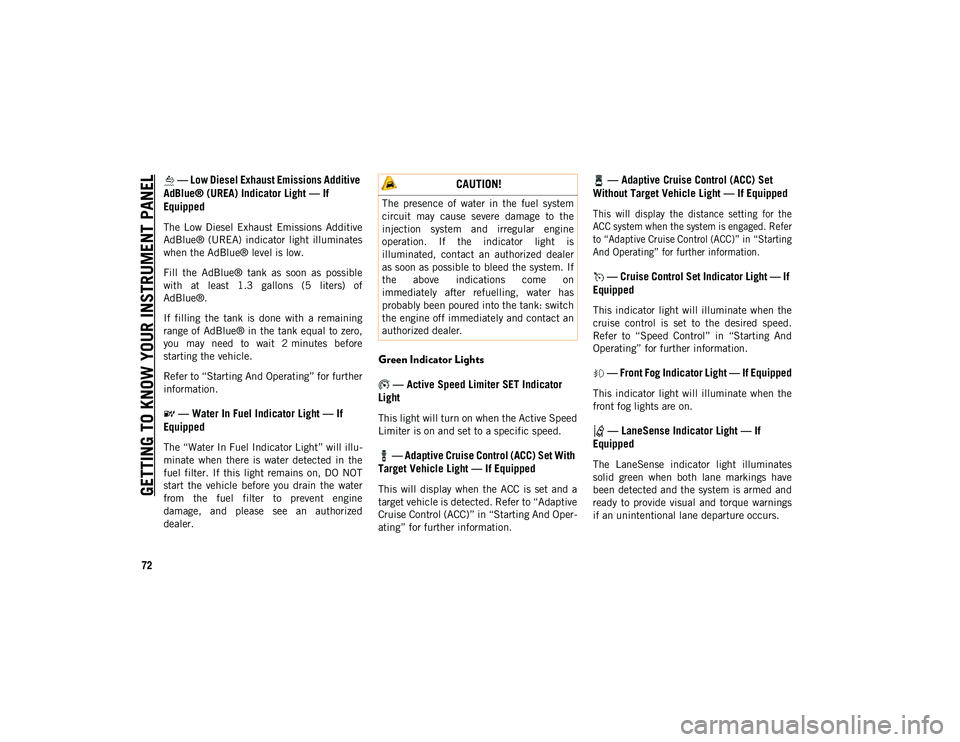
GETTING TO KNOW YOUR INSTRUMENT PANEL
72
— Low Diesel Exhaust Emissions Additive
AdBlue® (UREA) Indicator Light — If
Equipped
The Low Diesel Exhaust Emissions Additive
AdBlue® (UREA) indicator light illuminates
when the AdBlue® level is low.
Fill the AdBlue® tank as soon as possible
with at least 1.3 gallons (5 liters) of
AdBlue®.
If filling the tank is done with a remaining
range of AdBlue® in the tank equal to zero,
you may need to wait 2 minutes before
starting the vehicle.
Refer to “Starting And Operating” for further
information.
— Water In Fuel Indicator Light — If
Equipped
The “Water In Fuel Indicator Light” will illu -
minate when there is water detected in the
fuel filter. If this light remains on, DO NOT
start the vehicle before you drain the water
from the fuel filter to prevent engine
damage, and please see an authorized
dealer.
Green Indicator Lights
— Active Speed Limiter SET Indicator
Light
This light will turn on when the Active Speed
Limiter is on and set to a specific speed.
— Adaptive Cruise Control (ACC) Set With
Target Vehicle Light — If Equipped
This will display when the ACC is set and a
target vehicle is detected. Refer to “Adaptive
Cruise Control (ACC)” in “Starting And Oper -
ating” for further information.
— Adaptive Cruise Control (ACC) Set
Without Target Vehicle Light — If Equipped
This will display the distance setting for the
ACC system when the system is engaged. Refer
to “Adaptive Cruise Control (ACC)” in “Starting
And Operating” for further information.
— Cruise Control Set Indicator Light — If
Equipped
This indicator light will illuminate when the
cruise control is set to the desired speed.
Refer to “Speed Control” in “Starting And
Operating” for further information.
— Front Fog Indicator Light — If Equipped
This indicator light will illuminate when the
front fog lights are on.
— LaneSense Indicator Light — If
Equipped
The LaneSense indicator light illuminates
solid green when both lane markings have
been detected and the system is armed and
ready to provide visual and torque warnings
if an unintentional lane departure occurs.
CAUTION!
The presence of water in the fuel system
circuit may cause severe damage to the
injection system and irregular engine
operation. If the indicator light is
illuminated, contact an authorized dealer
as soon as possible to bleed the system. If
the above indications come on
immediately after refuelling, water has
probably been poured into the tank: switch
the engine off immediately and contact an
authorized dealer.
2020_JEEP_CHEROKEE_UG_RHD_UK.book Page 72
Page 75 of 332
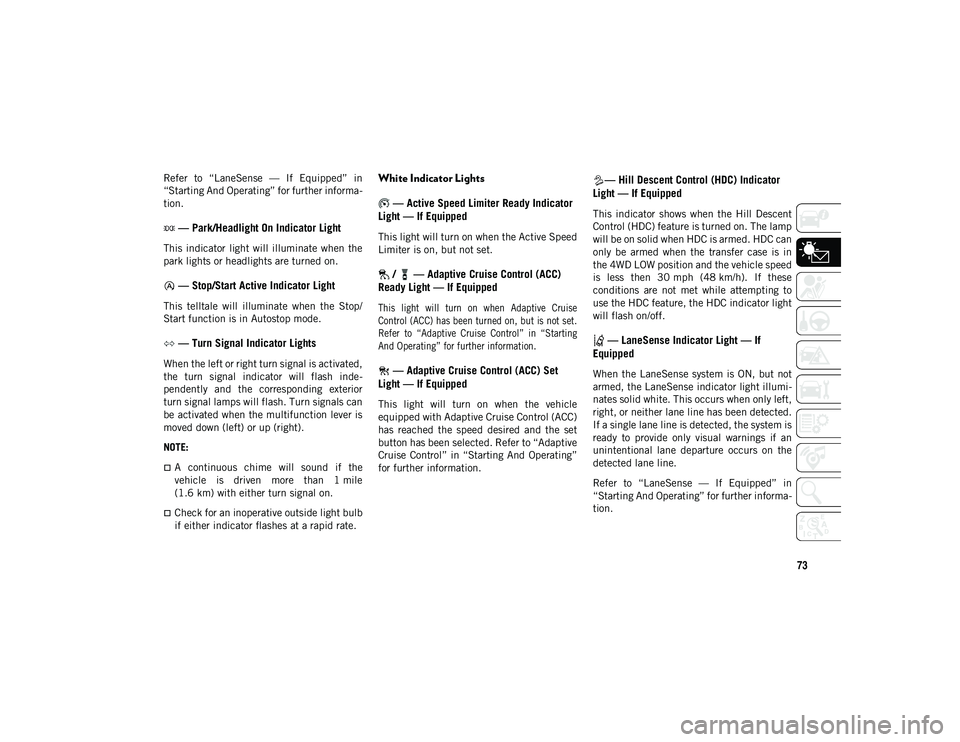
73
Refer to “LaneSense — If Equipped” in
“Starting And Operating” for further informa-
tion.
— Park/Headlight On Indicator Light
This indicator light will illuminate when the
park lights or headlights are turned on.
— Stop/Start Active Indicator Light
This telltale will illuminate when the Stop/
Start function is in Autostop mode.
— Turn Signal Indicator Lights
When the left or right turn signal is activated,
the turn signal indicator will flash inde -
pendently and the corresponding exterior
turn signal lamps will flash. Turn signals can
be activated when the multifunction lever is
moved down (left) or up (right).
NOTE:
A continuous chime will sound if the
vehicle is driven more than 1 mile
(1.6 km) with either turn signal on.
Check for an inoperative outside light bulb
if either indicator flashes at a rapid rate.
White Indicator Lights
— Active Speed Limiter Ready Indicator
Light — If Equipped
This light will turn on when the Active Speed
Limiter is on, but not set.
/ — Adaptive Cruise Control (ACC)
Ready Light — If Equipped
This light will turn on when Adaptive Cruise
Control (ACC) has been turned on, but is not set.
Refer to “Adaptive Cruise Control” in “Starting
And Operating” for further information.
— Adaptive Cruise Control (ACC) Set
Light — If Equipped
This light will turn on when the vehicle
equipped with Adaptive Cruise Control (ACC)
has reached the speed desired and the set
button has been selected. Refer to “Adaptive
Cruise Control” in “Starting And Operating”
for further information.
— Hill Descent Control (HDC) Indicator
Light — If Equipped
This indicator shows when the Hill Descent
Control (HDC) feature is turned on. The lamp
will be on solid when HDC is armed. HDC can
only be armed when the transfer case is in
the 4WD LOW position and the vehicle speed
is less then 30 mph (48 km/h). If these
conditions are not met while attempting to
use the HDC feature, the HDC indicator light
will flash on/off.
— LaneSense Indicator Light — If
Equipped
When the LaneSense system is ON, but not
armed, the LaneSense indicator light illumi -
nates solid white. This occurs when only left,
right, or neither lane line has been detected.
If a single lane line is detected, the system is
ready to provide only visual warnings if an
unintentional lane departure occurs on the
detected lane line.
Refer to “LaneSense — If Equipped” in
“Starting And Operating” for further informa -
tion.
2020_JEEP_CHEROKEE_UG_RHD_UK.book Page 73
Page 76 of 332
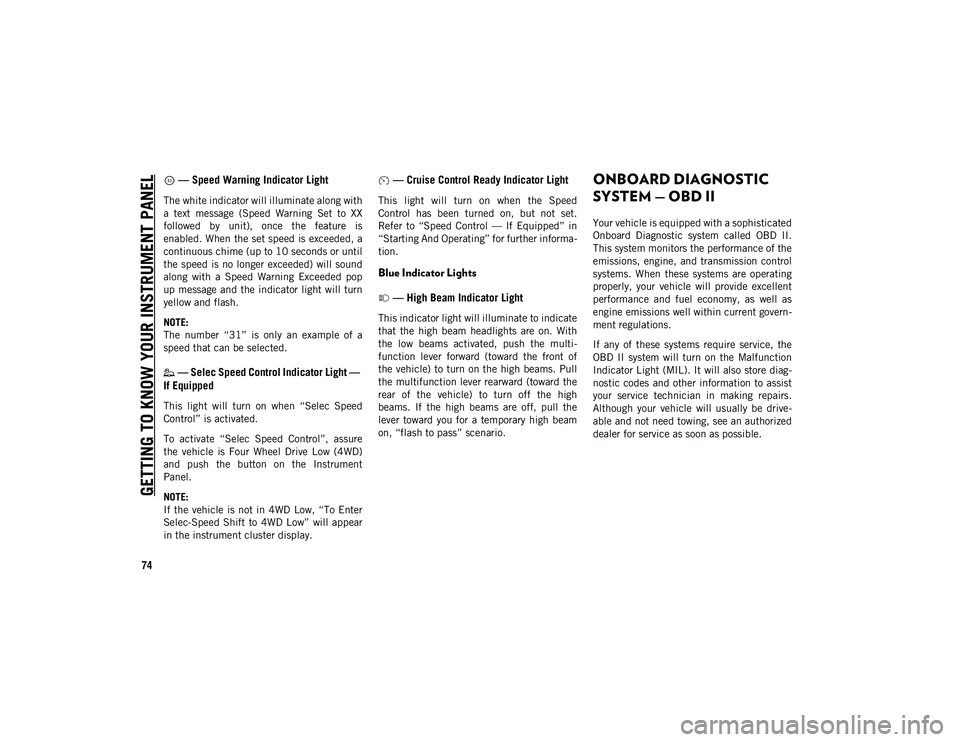
GETTING TO KNOW YOUR INSTRUMENT PANEL
74
— Speed Warning Indicator Light
The white indicator will illuminate along with
a text message (Speed Warning Set to XX
followed by unit), once the feature is
enabled. When the set speed is exceeded, a
continuous chime (up to 10 seconds or until
the speed is no longer exceeded) will sound
along with a Speed Warning Exceeded pop
up message and the indicator light will turn
yellow and flash.
NOTE:
The number “31” is only an example of a
speed that can be selected.
— Selec Speed Control Indicator Light —
If Equipped
This light will turn on when “Selec Speed
Control” is activated.
To activate “Selec Speed Control”, assure
the vehicle is Four Wheel Drive Low (4WD)
and push the button on the Instrument
Panel.
NOTE:
If the vehicle is not in 4WD Low, “To Enter
Selec-Speed Shift to 4WD Low” will appear
in the instrument cluster display.
— Cruise Control Ready Indicator Light
This light will turn on when the Speed
Control has been turned on, but not set.
Refer to “Speed Control — If Equipped” in
“Starting And Operating” for further informa -
tion.
Blue Indicator Lights
— High Beam Indicator Light
This indicator light will illuminate to indicate
that the high beam headlights are on. With
the low beams activated, push the multi -
function lever forward (toward the front of
the vehicle) to turn on the high beams. Pull
the multifunction lever rearward (toward the
rear of the vehicle) to turn off the high
beams. If the high beams are off, pull the
lever toward you for a temporary high beam
on, “flash to pass” scenario.
ONBOARD DIAGNOSTIC
SYSTEM — OBD II
Your vehicle is equipped with a sophisticated
Onboard Diagnostic system called OBD II.
This system monitors the performance of the
emissions, engine, and transmission control
systems. When these systems are operating
properly, your vehicle will provide excellent
performance and fuel economy, as well as
engine emissions well within current govern -
ment regulations.
If any of these systems require service, the
OBD II system will turn on the Malfunction
Indicator Light (MIL). It will also store diag -
nostic codes and other information to assist
your service technician in making repairs.
Although your vehicle will usually be drive -
able and not need towing, see an authorized
dealer for service as soon as possible.
2020_JEEP_CHEROKEE_UG_RHD_UK.book Page 74
Page 77 of 332
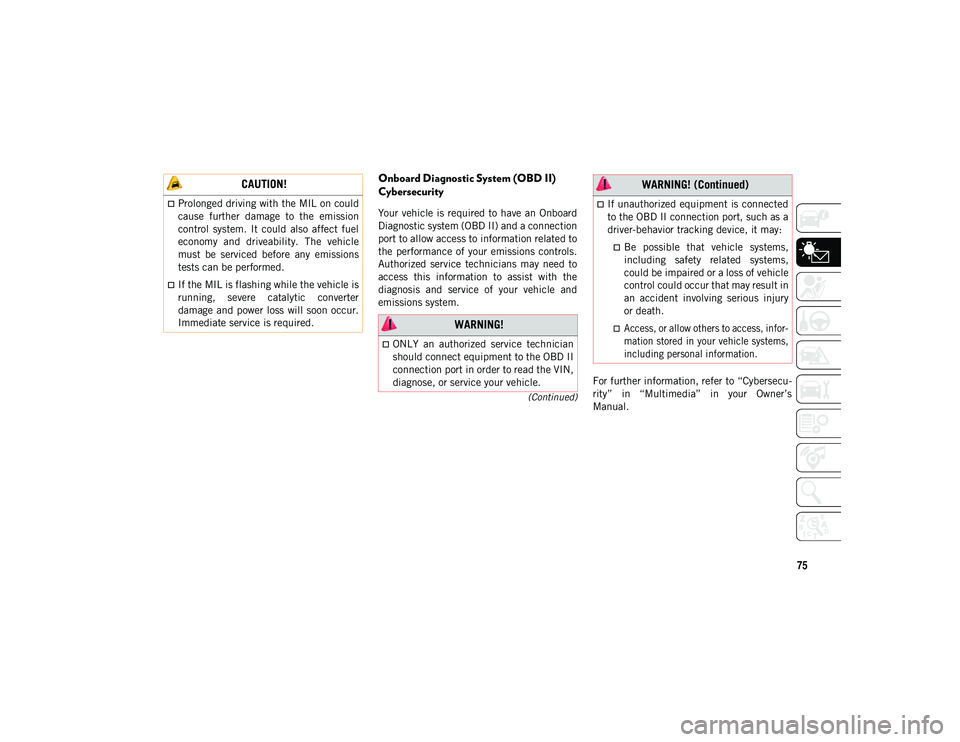
75
(Continued)
Onboard Diagnostic System (OBD II)
Cybersecurity
Your vehicle is required to have an Onboard
Diagnostic system (OBD II) and a connection
port to allow access to information related to
the performance of your emissions controls.
Authorized service technicians may need to
access this information to assist with the
diagnosis and service of your vehicle and
emissions system.For further information, refer to “Cybersecu-
rity” in “Multimedia” in your Owner’s
Manual.
CAUTION!
Prolonged driving with the MIL on could
cause further damage to the emission
control system. It could also affect fuel
economy and driveability. The vehicle
must be serviced before any emissions
tests can be performed.
If the MIL is flashing while the vehicle is
running, severe catalytic converter
damage and power loss will soon occur.
Immediate service is required.
WARNING!
ONLY an authorized service technician
should connect equipment to the OBD II
connection port in order to read the VIN,
diagnose, or service your vehicle.
If unauthorized equipment is connected
to the OBD II connection port, such as a
driver-behavior tracking device, it may:
Be possible that vehicle systems, including safety related systems,could be impaired or a loss of vehicle
control could occur that may result in
an accident involving serious injury
or death.
Access, or allow others to access, infor- mation stored in your vehicle systems, including personal information.
WARNING! (Continued)
2020_JEEP_CHEROKEE_UG_RHD_UK.book Page 75
Page 78 of 332
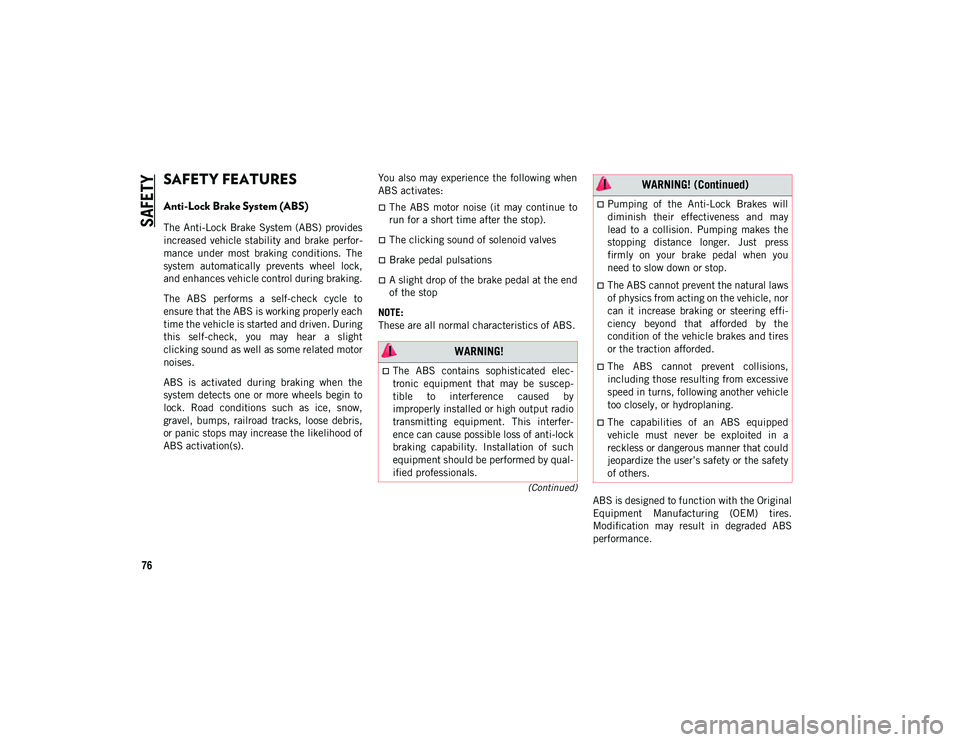
76
(Continued)
SAFETY
SAFETY FEATURES
Anti-Lock Brake System (ABS)
The Anti-Lock Brake System (ABS) provides
increased vehicle stability and brake perfor-
mance under most braking conditions. The
system automatically prevents wheel lock,
and enhances vehicle control during braking.
The ABS performs a self-check cycle to
ensure that the ABS is working properly each
time the vehicle is started and driven. During
this self-check, you may hear a slight
clicking sound as well as some related motor
noises.
ABS is activated during braking when the
system detects one or more wheels begin to
lock. Road conditions such as ice, snow,
gravel, bumps, railroad tracks, loose debris,
or panic stops may increase the likelihood of
ABS activation(s). You also may experience the following when
ABS activates:
The ABS motor noise (it may continue to
run for a short time after the stop).
The clicking sound of solenoid valves
Brake pedal pulsations
A slight drop of the brake pedal at the end
of the stop
NOTE:
These are all normal characteristics of ABS.
ABS is designed to function with the Original
Equipment Manufacturing (OEM) tires.
Modification may result in degraded ABS
performance.
WARNING!
The ABS contains sophisticated elec-
tronic equipment that may be suscep-
tible to interference caused by
improperly installed or high output radio
transmitting equipment. This interfer -
ence can cause possible loss of anti-lock
braking capability. Installation of such
equipment should be performed by qual -
ified professionals.
Pumping of the Anti-Lock Brakes will
diminish their effectiveness and may
lead to a collision. Pumping makes the
stopping distance longer. Just press
firmly on your brake pedal when you
need to slow down or stop.
The ABS cannot prevent the natural laws
of physics from acting on the vehicle, nor
can it increase braking or steering effi -
ciency beyond that afforded by the
condition of the vehicle brakes and tires
or the traction afforded.
The ABS cannot prevent collisions,
including those resulting from excessive
speed in turns, following another vehicle
too closely, or hydroplaning.
The capabilities of an ABS equipped
vehicle must never be exploited in a
reckless or dangerous manner that could
jeopardize the user’s safety or the safety
of others.
WARNING! (Continued)
2020_JEEP_CHEROKEE_UG_RHD_UK.book Page 76
Page 79 of 332
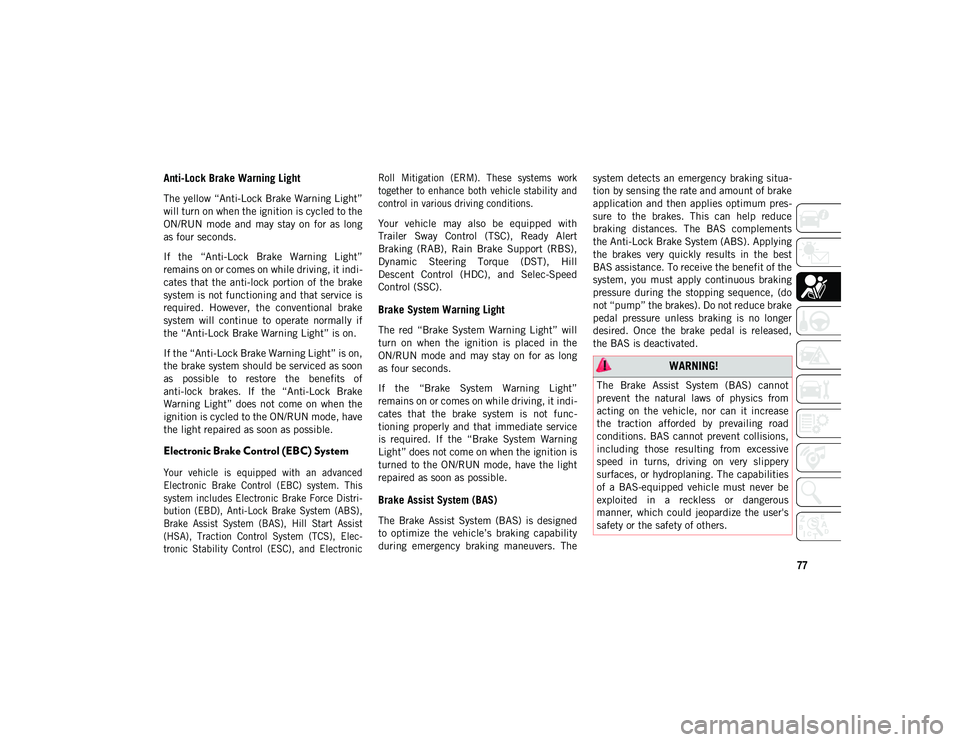
77
Anti-Lock Brake Warning Light
The yellow “Anti-Lock Brake Warning Light”
will turn on when the ignition is cycled to the
ON/RUN mode and may stay on for as long
as four seconds.
If the “Anti-Lock Brake Warning Light”
remains on or comes on while driving, it indi-
cates that the anti-lock portion of the brake
system is not functioning and that service is
required. However, the conventional brake
system will continue to operate normally if
the “Anti-Lock Brake Warning Light” is on.
If the “Anti-Lock Brake Warning Light” is on,
the brake system should be serviced as soon
as possible to restore the benefits of
anti-lock brakes. If the “Anti-Lock Brake
Warning Light” does not come on when the
ignition is cycled to the ON/RUN mode, have
the light repaired as soon as possible.
Electronic Brake Control (EBC) System
Your vehicle is equipped with an advanced
Electronic Brake Control (EBC) system. This
system includes Electronic Brake Force Distri -
bution (EBD), Anti-Lock Brake System (ABS),
Brake Assist System (BAS), Hill Start Assist
(HSA), Traction Control System (TCS), Elec-
tronic Stability Control (ESC), and Electronic Roll Mitigation (ERM). These systems work
together to enhance both vehicle stability and
control in various driving conditions.
Your vehicle may also be equipped with
Trailer Sway Control (TSC), Ready Alert
Braking (RAB), Rain Brake Support (RBS),
Dynamic Steering Torque (DST), Hill
Descent Control (HDC), and Selec-Speed
Control (SSC).
Brake System Warning Light
The red “Brake System Warning Light” will
turn on when the ignition is placed in the
ON/RUN mode and may stay on for as long
as four seconds.
If the “Brake System Warning Light”
remains on or comes on while driving, it indi
-
cates that the brake system is not func -
tioning properly and that immediate service
is required. If the “Brake System Warning
Light” does not come on when the ignition is
turned to the ON/RUN mode, have the light
repaired as soon as possible.
Brake Assist System (BAS)
The Brake Assist System (BAS) is designed
to optimize the vehicle’s braking capability
during emergency braking maneuvers. The system detects an emergency braking situa
-
tion by sensing the rate and amount of brake
application and then applies optimum pres -
sure to the brakes. This can help reduce
braking distances. The BAS complements
the Anti-Lock Brake System (ABS). Applying
the brakes very quickly results in the best
BAS assistance. To receive the benefit of the
system, you must apply continuous braking
pressure during the stopping sequence, (do
not “pump” the brakes). Do not reduce brake
pedal pressure unless braking is no longer
desired. Once the brake pedal is released,
the BAS is deactivated.
WARNING!
The Brake Assist System (BAS) cannot
prevent the natural laws of physics from
acting on the vehicle, nor can it increase
the traction afforded by prevailing road
conditions. BAS cannot prevent collisions,
including those resulting from excessive
speed in turns, driving on very slippery
surfaces, or hydroplaning. The capabilities
of a BAS-equipped vehicle must never be
exploited in a reckless or dangerous
manner, which could jeopardize the user's
safety or the safety of others.
2020_JEEP_CHEROKEE_UG_RHD_UK.book Page 77
Page 80 of 332
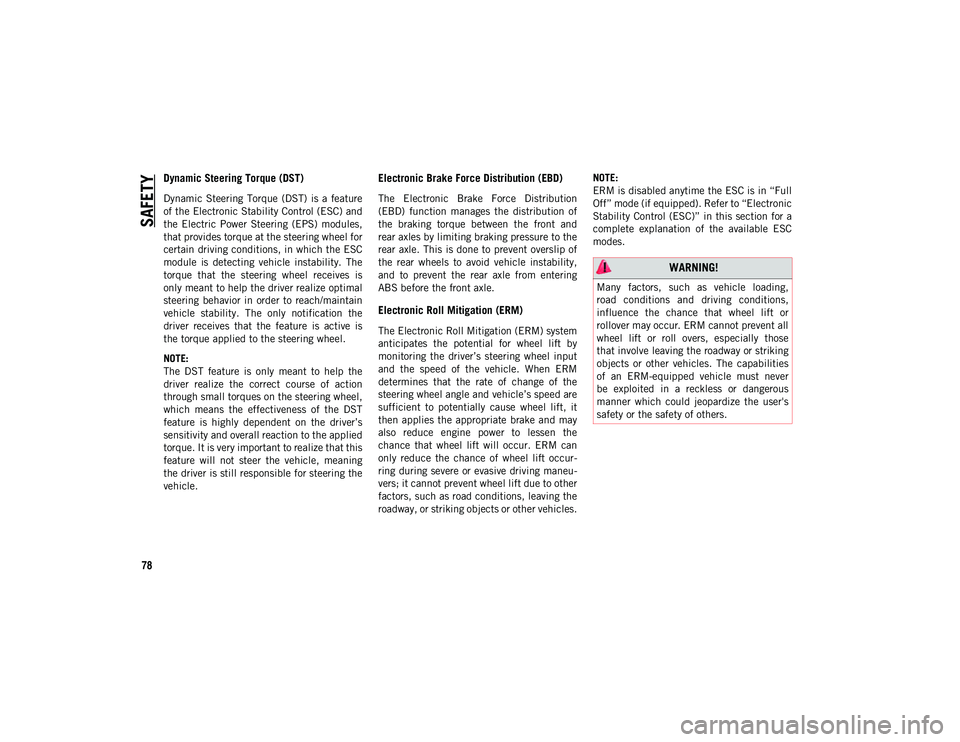
SAFETY
78
Dynamic Steering Torque (DST)
Dynamic Steering Torque (DST) is a feature
of the Electronic Stability Control (ESC) and
the Electric Power Steering (EPS) modules,
that provides torque at the steering wheel for
certain driving conditions, in which the ESC
module is detecting vehicle instability. The
torque that the steering wheel receives is
only meant to help the driver realize optimal
steering behavior in order to reach/maintain
vehicle stability. The only notification the
driver receives that the feature is active is
the torque applied to the steering wheel.
NOTE:
The DST feature is only meant to help the
driver realize the correct course of action
through small torques on the steering wheel,
which means the effectiveness of the DST
feature is highly dependent on the driver’s
sensitivity and overall reaction to the applied
torque. It is very important to realize that this
feature will not steer the vehicle, meaning
the driver is still responsible for steering the
vehicle.
Electronic Brake Force Distribution (EBD)
The Electronic Brake Force Distribution
(EBD) function manages the distribution of
the braking torque between the front and
rear axles by limiting braking pressure to the
rear axle. This is done to prevent overslip of
the rear wheels to avoid vehicle instability,
and to prevent the rear axle from entering
ABS before the front axle.
Electronic Roll Mitigation (ERM)
The Electronic Roll Mitigation (ERM) system
anticipates the potential for wheel lift by
monitoring the driver’s steering wheel input
and the speed of the vehicle. When ERM
determines that the rate of change of the
steering wheel angle and vehicle’s speed are
sufficient to potentially cause wheel lift, it
then applies the appropriate brake and may
also reduce engine power to lessen the
chance that wheel lift will occur. ERM can
only reduce the chance of wheel lift occur-
ring during severe or evasive driving maneu -
vers; it cannot prevent wheel lift due to other
factors, such as road conditions, leaving the
roadway, or striking objects or other vehicles. NOTE:
ERM is disabled anytime the ESC is in “Full
Off” mode (if equipped). Refer to “Electronic
Stability Control (ESC)” in this section for a
complete explanation of the available ESC
modes.
WARNING!
Many factors, such as vehicle loading,
road conditions and driving conditions,
influence the chance that wheel lift or
rollover may occur. ERM cannot prevent all
wheel lift or roll overs, especially those
that involve leaving the roadway or striking
objects or other vehicles. The capabilities
of an ERM-equipped vehicle must never
be exploited in a reckless or dangerous
manner which could jeopardize the user's
safety or the safety of others.
2020_JEEP_CHEROKEE_UG_RHD_UK.book Page 78